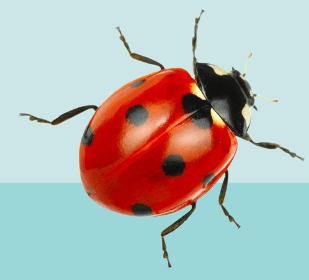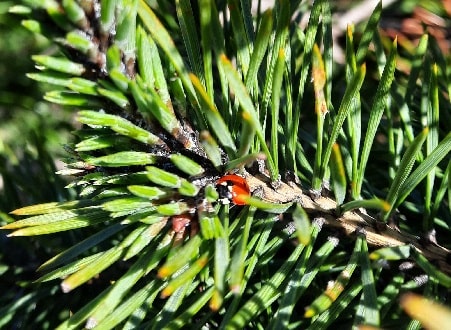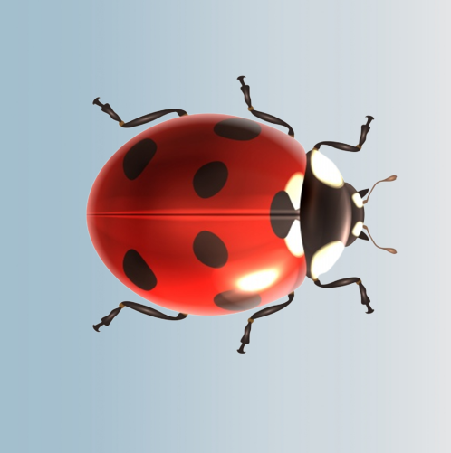A ladybug, also known as a ladybird or lady beetle, is a small beetle belonging to the family Coccinellidae. Ladybugs are widely recognized for their distinct appearance and are commonly found in gardens, fields, and forests around the world. They are typically small, round or oval-shaped insects, measuring around 1 to 10 millimeters in length, depending on the species.
Ladybugs have a characteristic domed shape and can vary in color and pattern. The most familiar ladybug species in North America, such as the seven-spotted ladybug (Coccinella septempunctata), are typically red or orange with black spots. However, ladybugs can also be black, yellow, brown, or even have no spots at all, depending on the species.
Ladybugs have a pair of translucent wings that are usually hidden under their colorful wing covers, called elytra. These wing covers help protect the delicate wings and body. Ladybugs can fly, and when they take flight, their colorful wings are revealed.

Ladybugs are beneficial insects in many ecosystems as they feed on plant pests such as aphids, mites, scale insects, and other soft-bodied insects. Both adult ladybugs and their larvae are voracious predators of these pests, making them valuable allies in natural pest control.
Ladybugs have a fascinating life cycle that typically includes four stages: egg, larva, pupa, and adult. The larvae are elongated and have a segmented body with distinct spots, and they undergo several molts before transforming into pupae. After a period of pupation, the adult ladybug emerges and starts its active life.
Ladybugs are not only beneficial in gardens but are also admired for their charming appearance. They are often considered symbols of good luck and are welcomed by gardeners for their pest control services.
What are the 3 things about ladybugs?
Here are three interesting facts about ladybugs (also known as ladybirds or lady beetles):
- Beneficial Garden Insects: Ladybugs are considered beneficial insects for gardeners. They are natural predators of many garden pests, particularly aphids. Adult ladybugs and their larvae feed on aphids, mites, scale insects, and other soft-bodied pests, helping to keep their populations in check.
- Colorful Appearance: Ladybugs are known for their vibrant and distinct appearance. While the most common ladybug species in North America is the red ladybug with black spots (Coccinella septempunctata), there are over 5,000 known species worldwide, and they come in various colors, including red, orange, yellow, and black, with varying numbers of spots or patterns.
- Defensive Mechanisms: Ladybugs have developed several defense mechanisms to protect themselves from predators. When threatened, they can release a yellowish fluid from their leg joints, which is distasteful and can deter predators. Some species also have bright colors or patterns that serve as warning signals to potential predators, indicating that they may be toxic or bad-tasting. This defense mechanism is known as aposematism.

Bonus Fact: Ladybugs are considered symbols of good luck in many cultures around the world. Their presence in gardens is often seen as a positive sign and is believed to bring good fortune.
Ladybugs are fascinating insects that provide natural pest control and add a splash of color to gardens. Observing their behavior and lifecycle can be a delightful experience for nature enthusiasts.
What are the benefits of ladybugs?
Ladybugs, also known as ladybirds or lady beetles, provide several benefits that make them valuable in various ecosystems and to gardeners. Here are some of the key benefits of ladybugs:
- Natural Pest Control: Ladybugs are voracious predators of many plant pests, particularly aphids. Both adult ladybugs and their larvae feed on aphids, mites, scale insects, mealybugs, and other soft-bodied insects. They can consume large numbers of these pests, helping to keep their populations in check and preventing damage to plants. Ladybugs are considered one of the most effective and environmentally friendly forms of biological pest control.
- Reducing the Need for Pesticides: By feeding on plant pests, ladybugs contribute to reducing the reliance on chemical pesticides. Gardeners and farmers can rely on ladybugs for natural pest control, minimizing the need for synthetic chemical interventions. This helps promote healthier ecosystems and reduces potential harm to beneficial insects, pollinators, and other wildlife.
- Balancing Ecosystems: Ladybugs play a crucial role in maintaining the balance of ecosystems. Their predatory nature helps control the populations of pests, preventing outbreaks and imbalances in the natural food chain. By reducing pest populations, ladybugs indirectly benefit other organisms in the ecosystem, including plants, insects, and birds.
- Pollination: While ladybugs are primarily known for their role as predators, some species also contribute to pollination. They can feed on pollen and nectar from various flowers, aiding in the transfer of pollen between plants and promoting pollination.
- Educational and Aesthetic Value: Ladybugs are beloved insects, admired for their vibrant colors and charming appearance. They often capture the interest and curiosity of people, particularly children, and serve as valuable educational tools to teach about the natural world. Ladybugs can also enhance the aesthetic appeal of gardens and outdoor spaces, adding a splash of color and beauty.
Overall, ladybugs are beneficial insects that provide natural pest control, support ecosystem balance, and offer educational and aesthetic value. Encouraging ladybug populations and creating garden habitats that attract them can be a sustainable and effective approach to maintaining healthy ecosystems and managing plant pests.
What ladybugs eat?
Ladybugs, both in their adult form and as larvae, primarily feed on various soft-bodied insects and their eggs. Their diet mainly consists of plant pests, making them valuable allies for natural pest control. Here are some of the common insects and small arthropods that ladybugs consume:
- Aphids: Ladybugs are particularly known for their appetite for aphids. Aphids are small, sap-sucking insects that can cause significant damage to plants. Ladybugs help keep aphid populations in check by feeding on them.
- Mites: Ladybugs also prey on mites, including spider mites and other plant-damaging mites. Mites are tiny arachnids that can infest and harm plants.
- Scale Insects: Scale insects are small, immobile pests that attach themselves to plants and feed on their sap. Ladybugs and their larvae consume scale insects, helping control their populations.
- Mealybugs: Mealybugs are soft-bodied insects covered in a waxy substance. They can infest plants and weaken them. Ladybugs feed on mealybugs, reducing their numbers.
- Whiteflies: Whiteflies are small, sap-sucking insects that often infest the undersides of plant leaves. Ladybugs prey on whiteflies, helping prevent damage caused by their feeding.
- Thrips: Thrips are tiny insects that can damage flowers and foliage. Ladybugs consume thrips and can help reduce their impact on plants.
- Other Small Insects: Ladybugs may also feed on small insects such as leafhoppers, plant bugs, and small caterpillars.
It’s important to note that different ladybug species may have slight variations in their preferred prey. Ladybug larvae, which often resemble tiny alligator-like creatures, are equally voracious predators and consume similar soft-bodied insects as their adult counterparts.
Ladybugs play a vital role in maintaining the balance of insect populations in ecosystems and are highly valued for their natural pest control abilities. Their diet primarily consists of plant pests, making them a beneficial presence in gardens, agricultural settings, and natural habitats.
Are ladybugs male or female?
Ladybugs include both male and female individuals, as they are sexually reproducing insects. Like many other organisms, ladybugs exhibit sexual dimorphism, which means that males and females may have distinct physical characteristics that help differentiate them. While the overall body shape and coloration are generally similar between male and female ladybugs, there are some subtle differences that can be observed in certain species. These differences may include:
- Size: In some species, female ladybugs are slightly larger than males. However, this size difference can vary between species.
- Spot Pattern: In certain ladybug species, the number and arrangement of spots on their elytra (wing covers) may differ between males and females. However, spot patterns alone are not always reliable for determining the sex of ladybugs, as spot variation can occur within a single species.
- Behavior: In some ladybug species, males exhibit specific behaviors to attract females during mating season. These behaviors may include territorial defense, courtship rituals, or releasing pheromones to attract females.
It’s important to note that identifying the sex of individual ladybugs may be challenging without careful observation or specialized techniques. In most cases, for general observations or gardening purposes, distinguishing between male and female ladybugs may not be necessary.
Why is it called ladybug?
The name “ladybug” is believed to have originated from European folklore. These small, colorful beetles became associated with the Virgin Mary during the Middle Ages in Europe, leading to the name “ladybird” or “Our Lady’s bird.” Over time, this name transformed into “ladybug” in English-speaking countries. Is a ladybird 🐞 harmful and helpful?

The connection between ladybugs and the Virgin Mary can be traced back to a legend. According to the legend, during a time when crops were threatened by aphids, farmers prayed to the Virgin Mary for help. Ladybugs then appeared and devoured the pests, saving the crops. The red color of the ladybugs was seen as symbolic of the Virgin Mary’s cloak, and the black spots were seen as representing her joys and sorrows.
The association with the Virgin Mary and the belief in ladybugs as a symbol of good luck and protection persisted over the centuries, leading to the use of names such as “ladybird” and “ladybug” for these beetles.
It’s worth noting that the term “ladybug” is more commonly used in North America, while “ladybird” is more prevalent in Europe and other parts of the world. However, the two terms generally refer to the same group of beetles in the family Coccinellidae. What does ladybugs drink? >>
What does the ladybug with 7 spots mean?
Ladybugs with seven spots are often associated with good luck and are considered symbols of good fortune in many cultures. The number of spots on a ladybug can vary depending on the species, and while some ladybugs have more or fewer spots, the seven-spotted ladybug (Coccinella septempunctata) is one of the most common and well-known species with this spot pattern.
The belief in the luck associated with ladybugs dates back centuries and has been rooted in folklore and cultural traditions. Ladybugs are seen as positive omens and are associated with protection, happiness, and blessings. In some cultures, it is believed that if a ladybug lands on you, it brings good luck or a wish will be granted.
The significance of the seven spots can vary depending on cultural interpretations. In Christian folklore, the spots are often associated with the seven joys and sorrows of the Virgin Mary. In other traditions, the number seven is considered lucky and symbolizes completion, perfection, or divine blessings.
While the belief in ladybugs as symbols of good luck may not have a scientific basis, they continue to hold cultural significance and are regarded with positive sentiments in many societies. Ladybugs, including those with seven spots, are generally seen as charming and beneficial insects that provide natural pest control, adding to their positive reputation. Why is it called ladybug? >>

Ladybugs are fascinating insects that provide natural pest control and add a splash of color to gardens. Observing their behavior and lifecycle can be a delightful experience for nature enthusiasts.